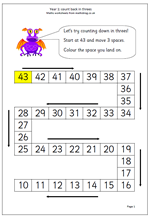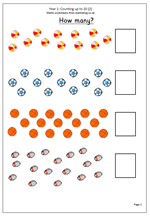 We are rapidly approaching the Christmas season in schools, with plenty of work going on preparing concerts, nativities etc. but the maths work still needs to go on, so here are a couple of worksheets for Year 1 children with a Christmas feel to them.
We are rapidly approaching the Christmas season in schools, with plenty of work going on preparing concerts, nativities etc. but the maths work still needs to go on, so here are a couple of worksheets for Year 1 children with a Christmas feel to them.
They look at counting on in whole tens from any 2-digit number, with answers up to 100. It is important that children are confident and happy with counting in ones up to 100 before starting this and some children may still need a number square to help them with this. Counting on in tens also helps with the understanding of partitioning numbers into tens and units and it is important to ask children what is happening, both to the tens and the units.








